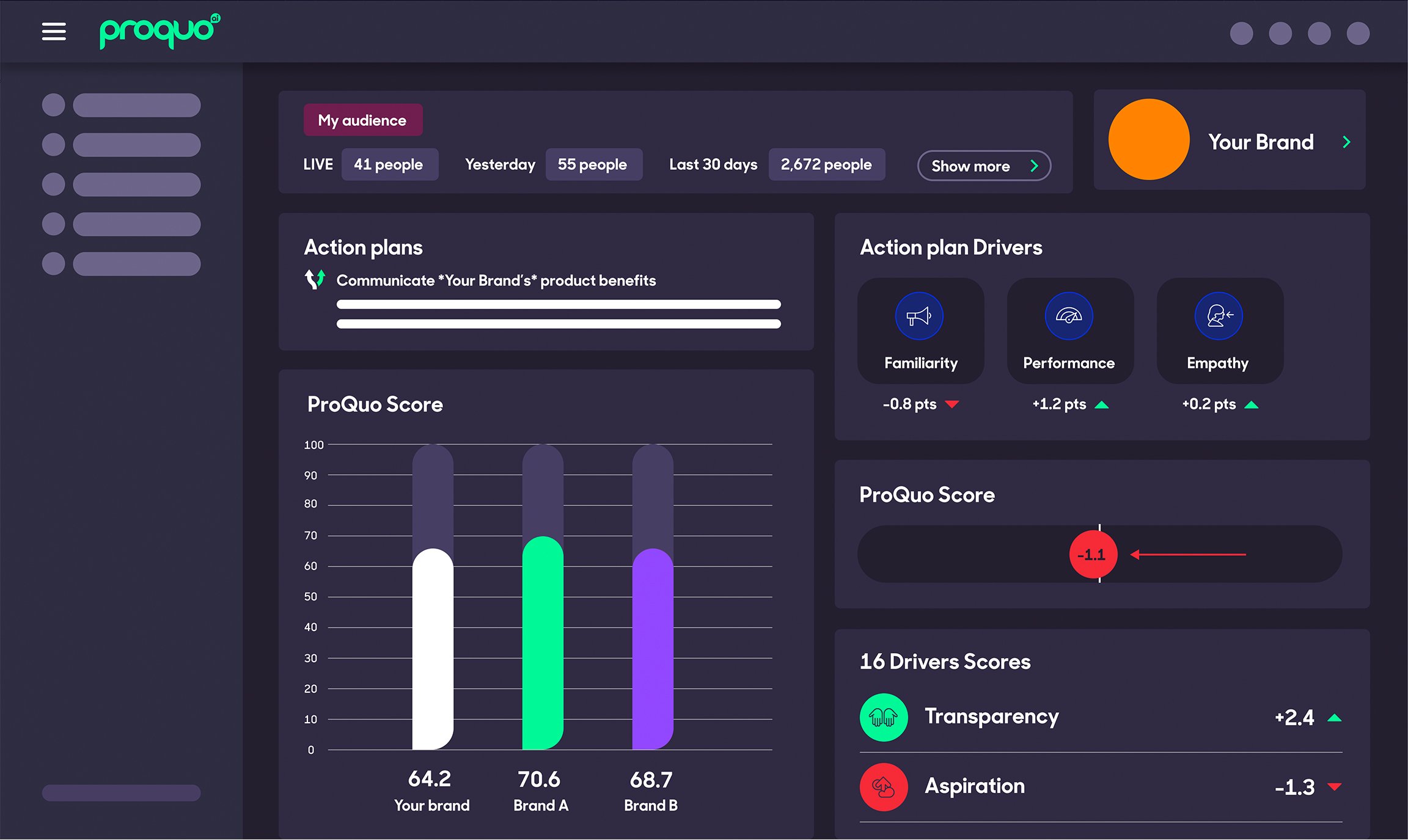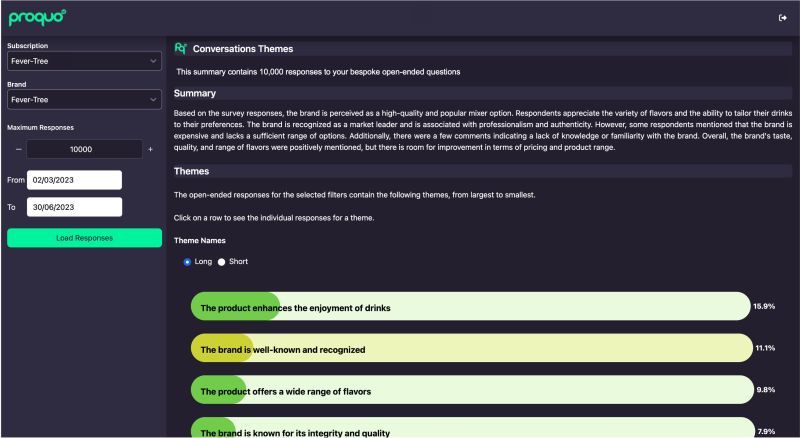Posted on December 7, 2023
Updated on December 7, 2023
5 min read time

Every brand manager in the B2C industry should master the intricacies of consumer sentiment. Understanding consumer sentiment isn't advantageous; it is a strategic imperative.
Consumer intelligence encompasses your target audience's collective mood and perceptions. It acts as a compass that guides your brand strategies, marketing campaigns, and product development.
By understanding the intricacies of the consumer mindset, brand managers can create more resonant campaigns, enhance customer experiences, and ultimately foster relationships with customers.
Let's dive into the world of consumer sentiment!
Consumer sentiment reflects the heartbeat of market trends, reflecting the pulse of economic conditions, personal finances, and purchasing intentions. By delving into the emotions and decision-making processes that drive consumer behavior, brand managers gain valuable insights into how their products or services fit into the broader narrative of consumer preferences.
Now, let's consider the emotional and rational side of consumer sentiment.
Daniel Kahneman, Nobel Prize-winning psychologist and economist, developed the dual-process theory of human cognition in behavioral economics.
System 1 thinking is crucial in analyzing customer sentiment. This type of thinking is automatic, intuitive, and responsible for our spontaneous reactions and judgments. In the context of customer sentiment, System 1 thinking is responsible for our immediate, emotional responses to a brand or product. These feelings are often rooted in instinct and gut reactions and can significantly impact our purchasing decisions.
For businesses looking to understand and leverage customer sentiment, delving into System 1 thinking is essential. By deciphering these implicit feelings and understanding what drives consumer behavior, companies can tailor their marketing strategies to resonate more authentically with customers, creating a more profound and lasting impact.
System 1 is what you'd want to capture to truly predict how people will make decisions and take action.
Brittany Pinney, CRO, ProQuo AI
Implicit feelings are the unspoken, emotional undercurrents that heavily influence a customer's overall experience with a brand. These feelings can be triggered by various sources, such as previous interactions, brand imagery, or even subtle cues in marketing materials. Analyzing implicit feelings requires a nuanced approach, often tapping into psychological insights to uncover the emotional triggers that resonate with customers.

System 2 thinking is characterized by explicit and deliberate cognitive processes. This mode of thinking is slower and analytical, involving conscious reasoning and logical evaluation. Explicit thoughts refer to the opinions, preferences, and rational assessments that consumers consciously express about a brand. These may include considerations of product specifications, pricing, reviews, and other criteria that influence purchase decisions.
By deciphering these explicit thoughts, companies can align more closely with the rational concerns of their target audience, fostering trust and satisfaction in the minds of consumers.
Let's move on to different methods of analyzing consumer sentiment, including surveys, social media, and online reviews. Understanding these diverse channels is essential for any brand wishing to connect with its audience on a deeper level.
Surveys and questionnaires are classic yet indispensable tools for businesses. Brands can systematically collect structured data by creating targeted inquiries to uncover valuable insights into consumer preferences, satisfaction levels, and brand perceptions. This method can offer both qualitative and quantitative approaches to understanding the multifaceted landscape of consumer sentiment. Surveys and questionnaires also help capture sentiment among a representative group of target consumers. However, responses can be less authentic and require careful cleaning.
Capturing people's thoughts about a brand is relatively straightforward. Capturing their feelings, however, is notoriously hard. At ProQuo AI, our brand tracking platform uses a refined data analysis method backed by years of research and data and behavioral sciences. We use an industry-leading Implicit Response Timing approach when asking people how they feel about your brand. This form of IRT leads to cleaner data, eliminating 20-30% of inaccurate responses compared to the industry standard of 7-8%.

Social media platforms have become an essential channel for consumers to express their opinions, experiences, and emotions about a brand or a product. Consumers can give instant feedback through comments, likes, shares, or direct messages.
Social media monitoring tools can track mentions, hashtags, and keywords related to a brand's products or services. By analyzing these mentions, brands can gain insights into how they are perceived online. This includes explicit comments and sentiment analysis to understand the overall tone of conversations—whether they are positive, negative, or neutral.
Consumer opinions expressed through online reviews and feedback platforms serve as a rich source of qualitative data for sentiment analysis. Whether on e-commerce websites, dedicated review platforms, or even within a company's website, customers often share their experiences and opinions regarding products and services.
Mining user-generated content provides authentic insights into explicit thoughts. Online reviews capture real experiences but miss the opinions of non-users. Surveys performed by brand tracking tools can monitor users' and non-users' thoughts and feelings, giving you a complete picture of the brand's perception.
Thanks to the strides made in evolving AI, consumer intelligence has seen its fair share of improvements. Let's look at how Natural Language Processing and Artificial Intelligence impact the efficiency of conducting consumer sentiment analysis.
One of the most important technologies that has led this transformation is Natural Language Processing (NLP).
NLP enables consumer intelligence tools to understand and interpret language. Brands can categorize sentiments, identify key themes, and understand the nuances of consumer opinions by applying NLP algorithms to surveys, social media posts, customer reviews, and other textual data. This technology goes beyond merely detecting positive or negative sentiments, allowing for a more nuanced comprehension of the emotions, context, and subtleties that shape consumer perceptions.
Consumer sentiment analysis is greatly improved by Artificial Intelligence, particularly machine learning algorithms. With AI's ability to process vast amounts of data and learn from patterns, its performance continually improves over time.
In consumer sentiment, AI can efficiently analyze text and visual content, providing a flexible solution for businesses to keep up with the ever-increasing volume of online data.
At ProQuo AI, we're finding the right tools for the job, combining the established numerical models with the nascent language ones to provide trustworthy, real-time insights.
Carl Sandrock, Head of Data Science and AI, ProQuo AI
ProQuo AI's recently launched Conversation App is an excellent example of applying NLP and AI in consumer sentiment analysis. Within seconds, you can analyze thousands of survey responses and categorize them. The summarized answers are the result of any question you want to ask. These technological advancements allow brand managers to leverage a much shorter time-to-insight.

In the light of modern technologies improving the ways consumer sentiment can be analyzed, it's equally important to arrive at these insights quickly. In real-time, to be precise.
Brands that harness real-time sentiment analysis gain a competitive advantage. They can stay ahead of shifts in consumer preferences and swiftly address emerging issues.
It’s also important that your brand's perception is measured against your competition on the same scale. Brands can gain a competitive edge by analyzing the sentiment of rival products to identify strengths, weaknesses, and opportunities for differentiation.
At ProQuo AI, we track consumer sentiment daily using our the 16 Equity Drivers. These Drivers give you granularity into how your brand—and your competitors—are performing. Combined with daily tracking, you can analyze both when and how consumer sentiment is changing in your category.
The value of consumer sentiment analysis for brands lies in gathering and translating that data into actionable strategies. Once collected, sentiment data must be processed and analyzed to extract meaningful insights.
As insights and brand teams are aware, ensuring that data is actioned by the marketing team is no easy feat. For both sides to be satisfied, the platform you're using to analyze consumer sentiment should:
Integrating consumer sentiment analysis into crucial decision points, such as product development, marketing strategies, and customer service initiatives, empowers brands to make strategic, informed choices.
Last but not least, continuous monitoring helps brands adapt strategies promptly to changing sentiment. Whether through social media listening or analyzing customer surveys, it enables quick identification and resolution of issues and opportunities. This agility mitigates reputation risks and meets evolving consumer expectations for long-term success in a dynamic market.
If you want to master consumer sentiment analysis with ProQuo AI, book a demo today and we’ll show you how real-time, AI-powered brand tracking looks like!
Our intelligent platform will take your brand further, faster.
Don’t believe us?
© 2020-2023 ProQuo AI International
All rights reservedWebsite by Blend